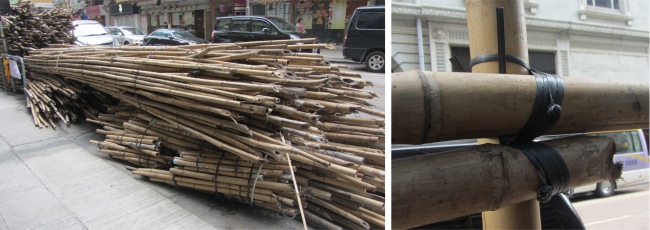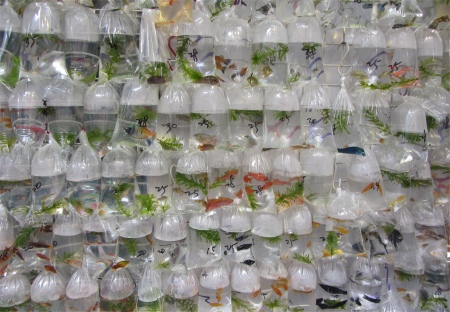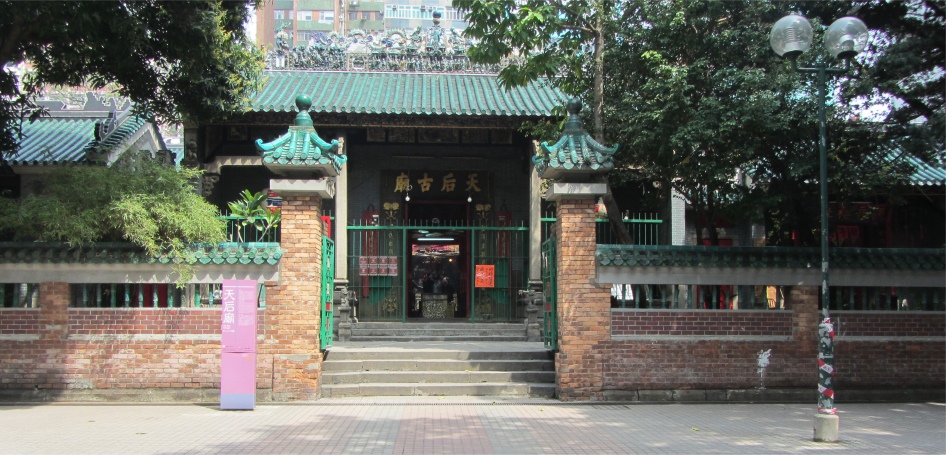
KCR Clock Tower
|

Flamingos in Kowloon Park
|
We were now in the Mong Kok district. Mong Kok used to be a Mango Plantation Village and it is difficult to imagine now. It has the reputation of being one of the most densely populated urban areas in the world. The best way to absorb its atmosphere is simply to walk the streets through the amazing pedestrian traffic. Cars and people fight for road space; nothing is considered a traffic jam because most of the time the cars are just waiting for people to finish crossing. Here exists the contrast of swanky hotel and shopping mall complexes sitting side by side with congested working-class residential areas. Possessing large residential and industrial areas, naturally led the markets and family businesses to cater largely to the Chinese. Tung Choi Street (Ladies Market) and Fa Yuen Street are the essence of Mong Kok. Ladies market specialises in women's wear and items, but men's and children's clothing can also be purchased. Things tend to be on the small side here, but the Chinese are small after all. Fa Yuen Street sells sports shoes and later turns into an outlet street market that locals tend to visit more. Sai Yeung Choi Street South specialised in electronic goods, which seemed to have mobile phone stores in every other building at one point. After dark the shop signs are lit up in all kinds of neon lights in Chinese, a picture postcard scene.
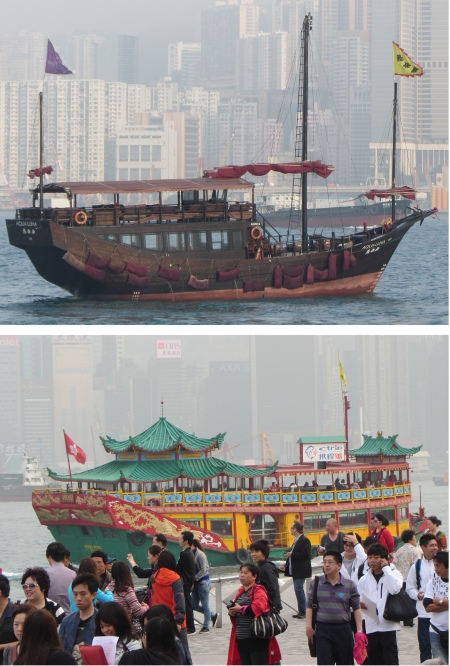
Boats in Victoria Harbour
|
Picking up the main drag of Nathan Road, we continued south into the Yau Ma Tei district. The Tin Hau Temple was our next stop off point. It is yet another one of the many temples in Hong Kong dedicated to the Goddess of the Sea. Like many buildings in the city, it is now high and dry after land reclamation deprived it of its waterfront site. The public square of this temple complex is a favourite place for Chinese chess players and acts as the communal heart of Yau Ma Tei. In front of the main temple, there is a row of fortune-tellers, who are only too keen to help temple visitors see into the future. The temple is also one of the most popular sites for the filming of Hong Kong gangster movies. Sadly photos could not be taken inside the temple, but sight is only one sense. The smell of the burning bunches of incense and spirals of burning incense hanging from the ceiling, plus the haunting sound of chants completed the experience.
The Jade Market, just west of Temple Street on the junction of Kansu and Battery Streets, is where vendors sell various shades and qualities of jade, a greenish stone found in East Asia. The Chinese believe that jade helps protect against evil spirits, and hordes of them were mingling amongst the 400 or so stalls in this covered market. Visitors would need to know exactly what they were up to before buying here, it is more a place for locals than for tourists.
Temple Street hosts the liveliest night market in Hong Kong. Countless stalls line the street selling clothing, footwear, fake watches and labels, pirated CDs and DVDs etc. etc., plus a lot of what I would call junk. It is the place to bargain. Singers covering a range of music from pop to Cantonese opera add to the gaiety of the area. I would align it to the souks in Marrakech. It used to be known as "Men's Street" since at one time it only sold men's clothing. It is a fascinating place to people watch. The northern end of the street is famed for its dai pai dong (Cantonese for "big rows of food stalls") that specialise in seafood. Here you can plonk yourself at a kerbside table and order anything from a bowl of noodles to a full meal.
The southern limit of the Yau Ma Tei district is full of narrow streets offering a more genuine "Chinese" feel to the city. The trade here became more traditional: tea, herbs, baked food, chopping blocks, dried seafood and embroidery could all be bought here; it reminded me of some of the back streets in Marrakech.

Enjoying a Beer by Victoria Harbour
|
South of Austin Road lay Kowloon Park. During the 19th-century, this was a military base, but in 1970 it was redeveloped into an all-in-one recreational area. A natural lung for families to roam in, it features Chinese gardens, a sculpture garden, a maze, a water garden, a lake and an aviary. Indoor and outdoor swimming pools add to the get-away-from-it-all atmosphere. Free martial arts performances are held here every Sunday. Today tai chi was being practiced by a large group in a courtyard. As we watched them, classes of school children were gathering with their teachers nearby, all well behaved and paying instant attention to the members of staff. The park was a honey trap for parents with pre-school age kids.
We left the park and returned to the famous Nathan Road, a wide, straight road stretching north up through Kowloon for 4km to the border with the New Territories. Sir Matthew Nathan was the governor of Hong Kong 1904 - 1907, and the road was constructed during his reign. At the time the road was considered too wide for the sparse population of Kowloon, and seemingly lead to nowhere, so it acquired the nickname "Nathan's Folly". Today the southern end of the road is known as the Golden Mile, full of boutiques, jewellery stores, electronics stores and the likes. The streets also teem with traders selling everything from pirated DVDs, fake watches, suits, clothing and anything they think they can sell. The energy of the area is unbelievable.

Hong Kong Island Architectures
|
Hugging the southern end of the peninsula, Tsim Sha Tsui provides a focus for tourists with hotels, restaurants, bars, shops and museums crammed into an impossibly small area. To the east lies Tsim Sha Tsui East, naturally, which is built upon reclaimed land. This district is trying to emulate its neighbour in terms of facilities.
We ambled down to the KCR Clock Tower. This was completed in 1921, and is the only remaining structure of Hong Kong's old train station. I tried to imagine what it must have been like in the days when passengers travelling on the Orient Express from London set foot at this final stop of their journey. It would have been a very different scenario in those days. The station was moved in 1975, and since then the tower has been dwarfed by the growing forest of buildings around it.
The salmon-coloured Hong Kong Cultural Centre now occupies the site of the former train station. Since 1989, this venue has been the city's largest arena for the performing arts. For some unknown reason the building has no windows facing out across the spectacular waterfront.
From the Clock Tower, we took a long stroll up the, Tsim Sha Tsui Promenade a charming open-air walkway that skirted the harbour all the way to Hung Hom, and affording stunning views of Hong Kong Island. The nearest I had come to such a walkway before was the walk I had around
Stanley Park in Vancouver during my Rockies trip. The walkway was full of walkers, well what do you expect, joggers, musicians, couples uttering their undying love for each other (my Cantonese has improved!), families and fishermen.
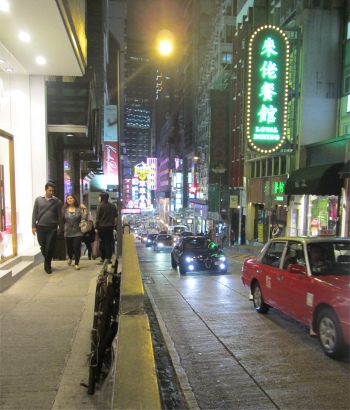
Wellington Road at Night
|
In the course of 1 kilometre we had each been through about a dozen surveys by different groups of school kids. They spoke pretty good English, and sought our views on food, transport, favourite sights, how much we spent on food and accommodation etc. etc. Quite a few wanted us to pose with them for photos too.
The promenade pays homage to the Hong Kong film industry in the Avenue of the Stars, featuring handprints and sculptures of celebrities such as Bruce Lee and Jackie Chan. The Chinese were infatuated with this stretch of the promenade, and ritually took pictures of each other standing next to their favourite stars in a variety of poses. It is not just the west who are fixated on celebrities.
Dan and I were a natural target for what appeared to be holy men, dressed in colourful "night gowns", and with equally colourful, empty begging bowls. We just avoided them like the plague.
Across Victoria Harbour stood the precipitous "cliff faces" of a wall of high-rise buildings, almost like a forest, which climbed up to mid and higher levels of Hong Kong Island on which they stood.
A mist hung over this forest, obscuring the tops of some of the buildings and most of the upper heights of the island.
Ships and small craft of every description plied their way across and through the harbour.
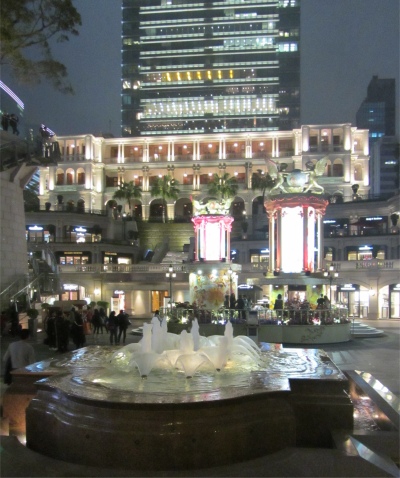
A Kowloon Plaza
|
By now we had been walking for over 5 hours, so we took a well-deserved rest in a harbour front bar. Sadly, we had to indulge in a beer whilst we took in the glorious harbour scene in front of us, and studied the legions of tourists parading along the promenade in front of us. Small groups of Chinese would be taking photos, younger groups giggling while elder members would stand stiffly and show no emotion whatsoever. Groups of Indians would take photos of every possible combination and permutation of their members. Crumbs, if all these photos were being stored digitally, then we must have watched Terabytes being recorded.
Since the Star Ferries only take a few minutes to make the crossing to the island, and are ludicrously cheap, we decided to take a ferry across to Wan Chai, and from there we took a haphazard route across to the International Finance Centre building, and enjoyed a beer in the Red Bar therein, rubbing shoulders with suited bankers and office workers, many being expatriates.
By now we were quite hungry. We headed inland through a maze of streets that occupy the narrow strip of land between the harbour and the peaks, and found a small restaurant, Chinese of course, and had a bite to eat. The restaurant lay on Wellington Road, a colourful splash of neon lights framed against a night sky, animated by a constant to and fro of humanity.
With our energy levels suitably replenished, we returned to Kowloon and made our way to Knutsford Terrace, in reality a back lane crammed full with bars and restaurants, where we spent a couple of hours in a bar full of pool tables and darts boards. I am totally amazed at how these places run. It seems to be chaotic how orders are placed, services delivered, bills presented and payments made, but it works magically. All the staff seemed to know their little niche and just get on with it. Organised chaos works in this land.
